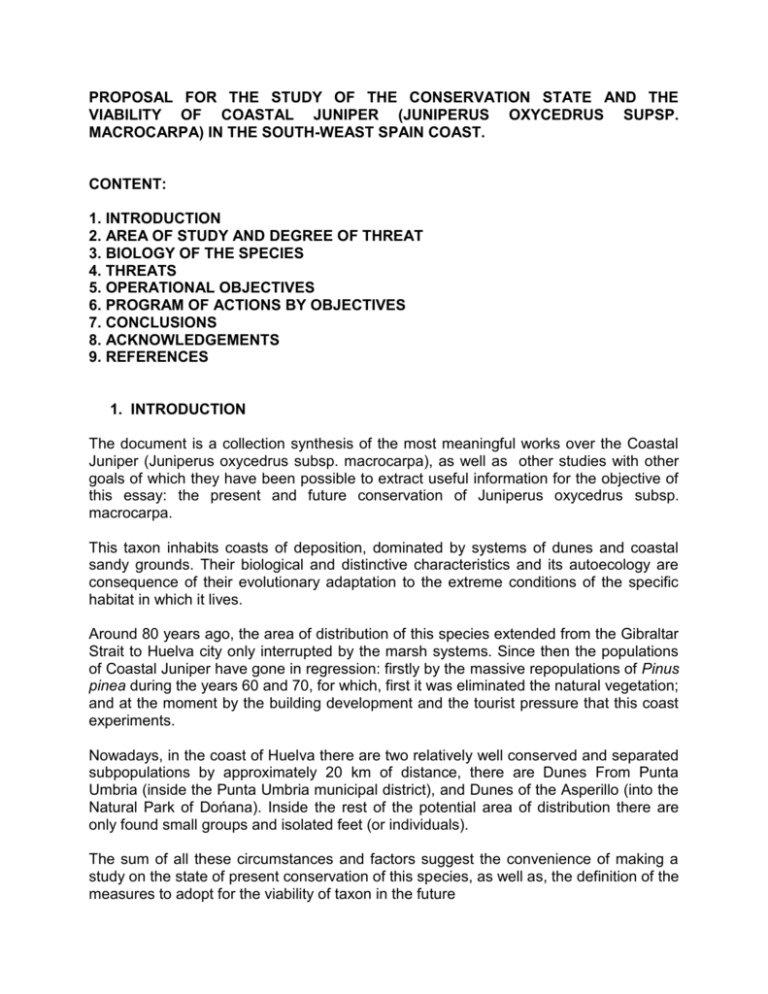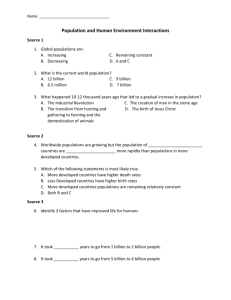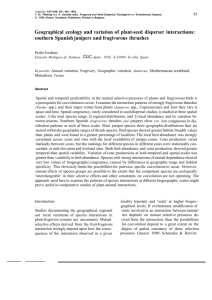4. threats
advertisement

PROPOSAL FOR THE STUDY OF THE CONSERVATION STATE AND THE VIABILITY OF COASTAL JUNIPER (JUNIPERUS OXYCEDRUS SUPSP. MACROCARPA) IN THE SOUTH-WEAST SPAIN COAST. CONTENT: 1. INTRODUCTION 2. AREA OF STUDY AND DEGREE OF THREAT 3. BIOLOGY OF THE SPECIES 4. THREATS 5. OPERATIONAL OBJECTIVES 6. PROGRAM OF ACTIONS BY OBJECTIVES 7. CONCLUSIONS 8. ACKNOWLEDGEMENTS 9. REFERENCES 1. INTRODUCTION The document is a collection synthesis of the most meaningful works over the Coastal Juniper (Juniperus oxycedrus subsp. macrocarpa), as well as other studies with other goals of which they have been possible to extract useful information for the objective of this essay: the present and future conservation of Juniperus oxycedrus subsp. macrocarpa. This taxon inhabits coasts of deposition, dominated by systems of dunes and coastal sandy grounds. Their biological and distinctive characteristics and its autoecology are consequence of their evolutionary adaptation to the extreme conditions of the specific habitat in which it lives. Around 80 years ago, the area of distribution of this species extended from the Gibraltar Strait to Huelva city only interrupted by the marsh systems. Since then the populations of Coastal Juniper have gone in regression: firstly by the massive repopulations of Pinus pinea during the years 60 and 70, for which, first it was eliminated the natural vegetation; and at the moment by the building development and the tourist pressure that this coast experiments. Nowadays, in the coast of Huelva there are two relatively well conserved and separated subpopulations by approximately 20 km of distance, there are Dunes From Punta Umbria (inside the Punta Umbria municipal district), and Dunes of the Asperillo (into the Natural Park of Dońana). Inside the rest of the potential area of distribution there are only found small groups and isolated feet (or individuals). The sum of all these circumstances and factors suggest the convenience of making a study on the state of present conservation of this species, as well as, the definition of the measures to adopt for the viability of taxon in the future 1. AREA OF STUDY AND DEGREE OF THREAT This species, catalogued in threat of extinction, is present solely in the seaboard ecosystems on stabilized dunes of the Andalusia Atlantic coast; an extensive coastal arc of approximately 250 km that is extended from Portugal to the Strait of Giblraltar. (CONSEJERIA DE MEDIO AMBIENTE DE ANDALUCIA, 2002. Project Juniper). The study area is characterized for being the contact between the Earth and the sea, circumstance which causes that they were very dynamics and specifics environment. The main factors of dynamism are: the processes of the marine dynamical, the continental processes, characteristics of the climate and the biological influences, (NONN, 1987). Biogeographycally, the study area constitutes an individual set characterized like chorological province (Gaditano-Onubo-Algarbiense province) by its fisiographyc, bioclimatics and floristicals peculiarities (CEBALLOS and MARTIN BOLANOS, 1930; ASENSI IVORY and TEN GARRETAS, 1987). 3. BIOLOGY OF THE SPECIES The habitat of the coastal juniper, is reserved for plants specialized and adapted to survive under its hard conditions: high temperatures and summer isolation, poor in nutrients, little stable sandy ground and with low availability of water and discharge exhibition to the loaded marine wind of salt. The specialization of the juniper and its adaptations to this atmosphere are shown in some distinguishing characteristics: chroriaceas leaves to avoid the loss of moisture and the attack del loaded wind of salt and sand, fast growth of extensive roots, that allow him to survive to the movement of sands and to accede to the water of the deepest layers of the subsoil. Other particularities of this species are their slow growth, and a capacity of partly limited regeneration, by their dependency of small carnivores for the dispersion and germination of their seeds. In addition, the process of production of fruits occupies a long period of time (two years) since the fertilization is made by pollen that it is transported by the wind from the masculine feet that produces it. 4. THREATS The agents who threaten the survival of this taxon can be ordered within two main factors: 4.1. Autoecology of the species: - Slow growth. - Limited regeneration. - Important dependency of the local fauna for the dispersion of its seeds. - Long period (2 years) of maturation of the fruit. - Habitat of extreme climatic and edafic conditions. 4.2. High transformation of its habitat: - Disordered and untenable town-planning Development. - Forest management directed to economic interests so far of conservation interests. Case of the Pinus pinea. - Fragmentation of the distribution area. - Genetic isolation of the metapopulations. - Introduction of exotic invasive species. Case of the Carpobrotus edulis. - Excessive cattle pressure and public use too in area with presence of coastal juniper. -Some of the individuals are developed on private propierties that makes difficult its manegement. All these characteristics have given this species to a situation of clear regression and a diminution of the capacity of regeneration of their populations. 5. OPERATIONAL OBJECTIVES 5.1. Protection in situ. To establish and to apply effectively measures of direct protection on the natural populations and their habitat. 5.2. Conservation of the present genetic biodiversity. 5.3. To reinforce the populations in natural environment until obtaining viable populations. 5.4. To promote and to develop lines of investigation, (potential habitat, autoecology, factors of competition, etc.), that allow to improve the strategies of conservation of the species. 5.5. Monitorization of the populations to know its evolution and the effectiveness of the management measures. 5.6. To make aware and citizen collaboration 6. PROGRAM OF ACTIONS BY OBJECTIVES 6.1. To establish a treatment for the vegetation that competes with the juniper: tasks of cleared of the coastal pine that cohabits with the juniper and the elimination of the invading plant Carpobrotus edulis. The protected area will be extended by the figure of Places of Communitarian Interest (LIC´s) of those valuable zones located outside the Network of Protected Natural Spaces. Measures of control of the public use would be established. For example the construction of infrastructures that canalize the high transit of users of the coast: footbridges of access to the beach, protections of track-bike, structures that prevent the entrance of vehicles to the dune cord, etc, as well as the accomplishment of interpretative signals. 6.2. It will make a sufficient harvesting of seeds of each natural population. One part of these seeds will serve for the creation of a genetic bank of seeds of the species within the Andalusia Vegetal Seed Bank (conservation ex- situ). The other part will be used for production of plants in breeding grounds that then will serve for investigation, the reinforcement and the extension of the natural populations. 6.3. It will make repopulations, densification of populations and connective spaces. They were carried out with feet of coastal juniper produced in breeding grounds from native seeds of the local populations. So, It will try to reinforce the natural populations of the species very fragmented and with increasing problems of isolation among them. 6.4. It is fundamental to have information and knowledge of the factors that condition the survival of the species. In this sense the accomplishment of studies is contemplated on: the paper of the vertebrate fauna in its dispersion and germination or the answer of the junipers to the cleared of the pine groves with which they coexist. 6.5. Inventory: it will register the characteristics of each population, degree of threat and state of conservation. Monitoring: With the objective to update the diagnosis of the state of the present populations as well as to determine the effect of the management above its evolution and development. Information and analysis of the data: All the information produced by the diverse fronts of action of the Plan will be compiled, studied and stored so that it can be used later. Genetic studies: It will be made studies of genetic variability population inter and intra and of the variation of the rate of fertility between populations. 6.6. For the success of this conservation strategy, we considers very important the accomplishment of educative actions about the species and its problematical. These programs will go directed specially: to the students, the temporary visitors and the sectors of the population more affected by the forecasts of the Plan. In this sense, it will be helpful the introduction of the Project within the Andalusia Plan Of Environmental Voluntary and to establish agreements with institutions, public and private companies and particular for the conservation and recovery of individuals located in lands of private property. 7. CONCLUSIONS During the elaboration of this essay it has not found recent works of investigation centred in the species, that gather with numerical data the present problematica of this taxon. Also, the slow grow may be a handicap for the investigation. So that, we think that the propose activities of investigation in this essay are necessary and should be started as soon as it is possible. This study also suggest the important roll of the juniper within its habitat as much by its adaptations to the environment like by the narrow fenologic relations with to other native plants, vertebrate and invertebrate animals. We are sure that if we protect the juniper and its habitat, throw the above measures, we will be helping also to another threated species as Linx pardinus (endemic), Chamaeleo chamaeleon, Linaria tursica (endemic), and Corema album, so it will be protecting the biodiversity. The exploration of the area of distribution before and during this work, has shown that in many cases is not fulfilled legislation that protect the juniper and its habitat. Therefore throw of this essay we demand the strict fulfillment of the present legal measures as well as which are proposed in this work. Also important is the fulfillment in the agreements with publish and private organizations. If this later point is not made, the efforts of many cientifics, teachers, and particulars finally have not reward. 8. ACKNOWLEDGEMENTS Some people in to appeared during development of it: Yoli, for believe more than i myself who i could do it. Igüazel, for your good advice and your computer. Vojta, for your action in a concret situation, when it was not left any possibility. All them have put your sand grain to conserv the biodiversity. 9. REFERENCES BEJARANO PALMA R. (1997), Vegetacion y paisaje en la costa atlantica de Andalucia. Univ. De Sevilla. PARQUE NACIONAL CALDERA DE TABURIE, (2003). Plan de conservacion del habitat de cumbre. JOSE JIMENEZ G-H y PALOMA LOPEZ-IZQUIERDO B., (2005). Restauracion de la vegetacion en los pinares del Parque Nacional de Cabanero. Parque Nacional de Cabaneros. CONSERVACION DE HABITATS LITORALES DE LA PROVINCIA DE CADIZ LIFE03 NAT/E/000054, 15 de Septiembre de 2003 - 15 Marzo de 2006. CONSEJERIA DE MEDIO AMBIENTE DE ANDALUCIA, (2002). Proyecto Enebro. M. VAN DER MERWE, M.O. WINFIELD, G.M. ARNOLD and J.S. PARKER, (2000). Spatial and temporay aspects of the genetic structure of juniperus communis pupulacions. Molecular Ecology 9, 379-386. J. GERARD B. OOSTERMEIJER and BART OF KNEGT, 2004. Genetics population structure of the wind-pollinated, diaecious shrub Juniperus communis in fracmented Dutch heathlands. Plant Species Biology 19, 175-184. BALAGUER L. (2004), Plantas invasoras. Historia Natural 5: 32-41. JONATHAN L. GELBARD and JAYNE BELNAP, 2003. Roads as conduits for exotic plant invasions in a semiarid Landscape. Conservation Biology 17, 420-432. PARQUE NACIONAL DE DONANA, (2002). Informe sobre la eliminacion de espececies exoticas introducidas en el Parque Nacional de Donana. ANA TRAVESET and NURIA RIERA, 2005. Disruption of to Plant-Lizard Seed Dispersal System and Its Ecological Effects on to Threatened Endemic Plant in the Balearic Islands. Conservation Biology 19, 421-431. CONSEJERIA DE MEDIO AMBIENTE DE ANDALUCIA (1995), Plan Andaluz de Voluntariado Medio Ambiental. On Praha: 2006/05/09









